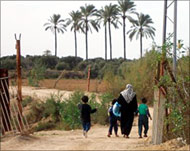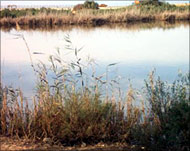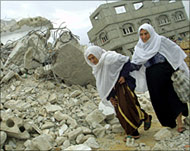Environmental concerns in Palestine
Visitors to Wadi Gaza, if they are familiar with the natural wetland’s reputation, will notice some amazing changes.

The Wadi, once notorious for its noxious sewage fumes, is virtually unrecognisable now.
Varieties of rare birds nestle over the Wadi’s serene waters, in the shade of indigenous grass and ferns. Nearby, cleared out hiking trails provide ample room for visitors to take in the scenery under the newly planted palm trees.
All this is the result of a recent UNDP project that is converting the Wadi and its vicinity from a sewage dump into a model national park.
The $3.5 million project, which is the first of its kind in Palestine, is part of a larger initiative aimed at conserving the wetlands and coastal ecosystems in the Mediterranean region.
However, the national park seems strikingly out of place in Gaza. After all, the overpopulated squalid strip of land is not exactly where one would envision hiking trails, bird watching towers, and a nature reserve.
Overcrowding concerns
With a population of nearly 1.2 million, Gaza is one of the most densely populated areas on earth, and with 80% of these people living below the poverty line, Gaza’s smell of despair is nearly suffocating.
Overcrowding, coupled with Israeli military closures, is the key reason, says the UNDP, why caring for the environment – and cleaning up Wadi Gaza, is a matter of Palestinian public health.
The project is also generating emergency employment opportunities while responding to real community needs, such as promoting agricultural development for area residents.
 |
|
Local children enjoy an escape |
The private lands of the Wadi, which have largely been neglected by the area’s poor residents, are now being transformed with their permission.
So far, a 7.5km hiking trail has been cleared out, three observation towers have been built, and about 35,000 indigenous plants and trees planted.
Hazards
The Wadi is nestled among three Jewish settlements and just a few kilometres away from Netzarim, where scores of Palestinians have been shot by trigger-happy Israeli troops in recent months, thus casting doubt on its potential as a national park.
But according to a leading member of the project’s management team, location is not a problem.
“It’s several kilometres away as you can see… and at the very least, it will be an outlet for the poor residents of this area, who are practically living on top of each other,” he said.
The reference was to the Nusairat refugee camp, located next door to the Wadi and housing about 60,000 refugees within less than one squared kilometre of space.
Choosing priorities
Nevertheless, many people continue to question whether caring for the environment is necessarily a priority during such difficult times. Gaza’s residents, they say, have many things on their mind. National parks are not one of them.
“Now, all that people care about are job opportunities,” said Ahmad Barghuth, head of the Gaza Green Peace Association and media consultant of the Wadi Gaza project.
“Several times [local residents] have threatened to prevent the project team from working on their land if jobs are not made available to them.”
 |
|
$3.5 million regenerated the site |
Barghuth says he had tried to speak to them about the promise of eco-tourism and the project’s impact on their children’s future, but the response is always the same.
“The typical thinking of over 90% of the area’s residents is ‘don’t tell me about tourism and what will happen in the future’. They want immediate relief and jobs so that their 10 kids can eat,” he explained.
As the Palestinian saying goes, ‘a bird in hand is worth 10 on the tree’.
However, Barghuth says he is still optimistic.
“It takes time… today I feel that the area residents are better than they were four years ago. Now they know how to take care of the lands, which gives me hope that it’s sustainable in the long term. Also, their children have been particularly responsive and engaged.”
“People are slowly becoming convinced that Wadi Gaza is not a dump site,” added a member of the team. “When they see their natural habitat cleaned up, they become encouraged to keep it clean and continue to care for it,” he said.
Catastrophic results
Yet, environmental problems are not limited to Wadi Gaza.
Years of neglect, occupation and abuse have created a multitude of environmental hazards throughout Palestine, resulting in what Jamal Safi, chairman of the Environmental Protection and Research Institute, calls “a catastrophic environment[al result]”.
|
“Israel is using the environment as a weapon against the Palestinians” Jamal Jumah, |
“We have [many] unseen but serious problems that are affecting our community… problems that not everyone knows about, such as a high rate of lead poisoning amongst children, the use of carcinogenic pesticides in farming and so on.”
In a recent research project conducted by EPRI, 75 out of 400 children were found to be suffering from lead poisoning. Moreover, 35 of these were mentally retarded due to dangerously high blood lead levels.
The effects of the Israeli occupation on the environment are particularly serious in the West Bank, where chemicals have been dumped, wildlife habitats disturbed, and water polluted.
Trees destroyed
“Israel is using the environment as a weapon against the Palestinians,” said Jamal Jumah, director of PENGON, the Palestinian Environmental NGOs Network.
“And when we talk about the environment, we’re talking about the Palestinian way of living,” he added.
According to Jumah, about one million trees have been uprooted since the start of the Intifada.
Each tree absorbs approximately 2.5 gallons of carbon dioxide. “So you can imagine how many gallons will remain in the sky and not be absorbed,” he explained.
The other major problem, according to Jumah, is chemical dumping. Five major Israeli industrial zones in the West Bank dump their toxic wastes on Palestinian land, with Tul Karam, Jenin, Hebron, and Qalqilya bearing the brunt of it all.
“If you see the medical statistics,” says Jumah, “you’ll find that the largest number of cancer cases is in Hebron and Tul Karam, where there is a pesticides factory.
“In Hebron, we think they are dumping other more dangerous chemicals. We haven’t proved it yet but we have our suspicions that they are dumping nuclear waste,” he adds.
 |
|
Many towns in Gaza are becoming |
Moreover, settlements, built strategically on top of hilltops in the West Bank, dump their sewage into the Palestinian villages located in the valleys below, polluting the water resources and soil.
The now-infamous West Bank apartheid wall is also wreaking environmental havoc, according to Jumah.
In addition to destroying thousands of acres of Palestinian farmland, the barrier is disrupting the natural habitat of the area’s wild animals, preventing them from migrating during change of seasons.
War on wildlife
“They are disrupting the nature here… it will be disastrous if they get rid of all Palestinian wildlife.”
Jumah says the problem is more political than anything else – no matter how many trees they re-plant or how many petitions they file, the overriding cause will not change.
“It’s a crime against humanity and nature and should be treated as such,” he said.
“We’re talking about polluting the air and water resources and getting rid of agricultural lands. All of this will have a drastic effect on the public health of the Palestinians.
“The environment is your existence: it’s the earth that you live on, the water that you drink, the air that you breathe… so if the Israelis poison all these things, it means it’s a war against your existence… and that’s exactly what’s happening,” Jumah added.